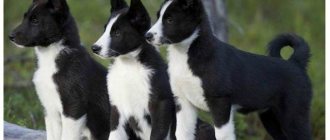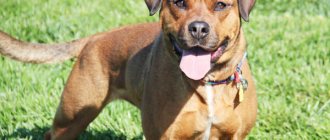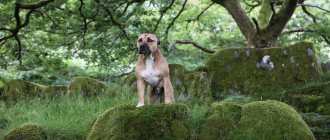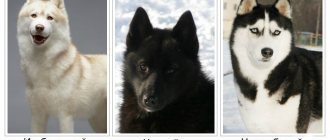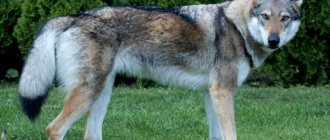Brief historical background
The history of the Icelandic Shepherd is rather vague. It is believed that their ancestors were the ancient Scandinavian Spitz-shaped dogs, which came to the territory of Iceland around the 9th-10th centuries. At first, the animals helped their owners in the hunt, but then, due to the lack of a large amount of game, they retrained as shepherds, expertly using the scent to find missing ones, strays from the herd, and stray sheep.
The appearance of the Icelandic dog has not changed for hundreds of years
Since then, the Icelandic Shepherd Husky has existed almost unchanged, because very few foreign dogs were brought to the island. An epidemic of an unknown disease that occurred in the 19th century, which first affected sheep and then spread to their four-legged shepherds, destroyed almost the entire livestock, as a result the breed was on the verge of extinction. The government took up its revival, issuing a decree in 1901 banning the export of representatives abroad.
Gradually the number of animals increased, in 1972 recognition was received by the world canine community, and at the same time the first breed standard was described. In the FCI registry, the Icelandic Sheepdog is included in group 5 “Spitz and dogs of a primitive type” (section 3 “Scandinavian guard and herding dogs”) under number 289. The last updated and current standard dates back to June 20, 2007.
Now the Icelandic Spitz is not in danger of extinction, but their numbers are small - about 16 thousand individuals.
History of the breed
Although very little evidence has been preserved about the time of the settlement of Iceland, ancient sagas and legends say that Icelandic sheepdogs came there along with people. They are the only native breed to these harsh islands, to which they have adapted through centuries of isolation.
The hardworking nature of the breed, its devotion and loyalty to its human companions were deeply revered among the people. They valued and revered these dogs so highly that they buried them as people.
Iceland's extreme climate created many problems, and there was a great famine in the 10th century. To survive, people killed and ate dogs, and only the smartest, healthiest and most needed managed to survive.
Since there were no large predators on the islands, or any animals in general, this meant that Icelandic Sheepdogs were not used as hunting dogs, and their character became friendly and strongly people-oriented.
Usually they were used not so much for guarding the herd, but for control and herding. They knew every sheep in their flock, distinguishing them from each other by smell. It is said that the Icelandic watchdog is so successful in this that he can find a sheep buried under several meters of snow.
Excellent cattle dogs, they are still used for this purpose and can handle larger animals such as horses. Cattle breeding received particular development in the Middle Ages and Icelandic dogs were often imported to neighboring countries. Especially in Great Britain, where they became favorite among the nobility and they compiled the first written descriptions of the breed. A merchant and navigator named Martin Behaim mentions them in 1492.
Documents about the breed continue to appear in the following years. Swedish author Olaf Magnus writes in 1555 that these dogs are very popular among Swedes, especially among women and priests. And in 1570, John Claus again names Icelandic dogs as one of the most popular among the British nobility.
Over time, this popularity spread throughout Europe and in 1763 these dogs were known even in Poland. Despite this, by the beginning of the 19th century, Icelandic guard dogs were on the verge of extinction.
The outbreak of an epidemic among sheep spreads to dogs, instantly spreading and destroying the animals. About three-quarters of dogs die as a result of the epidemic.
Due to a significant reduction in the population (including among reference breeders), dogs are beginning to be imported into the country from abroad. The author of a book about Icelandic Spitz, Christian Schierbeck traveled around the country in search of purebred dogs. He managed to find only 20 dogs that matched the original characteristics and those in remote peasant farms.
At that time, purebred Icelandic dogs were so rare that the price of a puppy was equal to the price of a good horse or several sheep. The government banned the import of dogs in 1901 to protect the population.
Gradually, the breed was restored and in 1969 the first club was created - Icelandic Dog Breeder Association (HRFÍ), in 1979 the second - Icelandic Sheepdog Breed Club. Club members are involved in drawing up a breed standard and breeding.
At the moment, about 4 thousand dogs are registered. Despite more than 1,000 years of history, the breed was not recognized by the AKC until July 2010.
Description of the Icelandic dog
Currently, Icelandic Shepherds can still be found on pastures in remote areas of Iceland, where they carry out their direct duties - herding sheep. They are used extremely rarely for hunting, but occasionally they help in the search for missing people and animals, and also perform guard functions. However, most often shepherd huskies are kept as companions and family pets, actively participating in all kinds of dog competitions and exhibitions.
Breed standard
The Scandinavian Shepherd is a well-built, lean, Spitz-shaped dog, slightly below average height, with a strong, slightly squat bone structure and well-developed muscles. A compact body of a stretched rectangular format with a flat, strong and muscular back, a not very long, wide, sloping croup, an elongated, deep, widened sternum and a slightly tucked belly. Males are noticeably more powerful and larger than females.
The Icelandic Shepherd is a small, but well-cut and compact dog.
Breed standard:
- A strong wedge-shaped head with a dome-shaped skull and a triangular muzzle tapering towards the nose, slightly longer than the skull, set on a high, curved, moderately long neck (without dewlap). The stop is clearly expressed.
- The nose is pigmented black or dark brown (in dogs with cream and chocolate coats).
- Jaws in a scissor bite with a full set of teeth. Black or dark brown lips fit tightly.
- The almond-shaped eyes are small with black eyelids. The iris is dark brown in color; in cream and chocolate individuals it is slightly lighter (brown eyelids). The look is smart, cute, cheerful and happy.
- Ears with rounded tips, triangular, erect, small, well express the mood of the animal, sensitively reacting to all sounds.
- Muscular, even, parallel legs, oval paws with arched, strong toes, tightly knit, and elastic pads.
- The high tail is curled into a ring and thrown over the back.
- Height at the withers (ideal): for bitches - 42 cm;
- for males - 46 cm.
The Icelandic Shepherd moves confidently and energetically, all movements are dexterous, light, very hardy and productive.
Features of the coat
The coat is very dense and thick, two-layered. There are two types of wool:
- Short coat, consisting of a rather coarse guard hair of medium length and a delicate soft undercoat. On the neck and chest the hair is longer, forming a collar, on the hind legs there are feathers, and the tail is well feathered. Shorter hair on the front legs and head.
- Long coat of roughish guard hair and thick soft down. Long hair on the back of the ears, chest and neck, feathering on the limbs, short hair on the top of the head, on the muzzle, as well as on the front of the ears and legs.
The Icelandic Shepherd's coat can be quite short.
The standard allows the following dominant colors:
- grey;
- black;
- all shades of red (orange);
- chocolate brown.
The main predominant tone is always followed by white markings (on the head, chest, limbs, tail). The fur on the belly and the entire lower part of the body, including the bottom of the tail, is a lighter shade. Individuals with light fur (gray and red) have a dark mask on their muzzle. Dogs with a dominant black coat have a tricolor color; along with the traditional white spots, there is a red tan on the paws, cheekbones, and characteristic eyebrows above the eyes. Variegated colors are allowed, when there are multi-colored spots on a white background.
Disadvantages and disqualifying characteristics
A defect is any deviation from the breed characteristics, its severity is assessed based on the degree of severity, as well as its effect on the well-being and health of the animal. Disadvantages include a black back in red dogs or solid black coloring (no spots).
The vices are:
- bulging or round eyes;
- yellow iris;
- absence of dewclaws.
Individuals with obvious mental, behavioral or physical disabilities are subject to disqualification.
Breed characteristics
Color: shades of orange, black and tan (tricolor), gray, chocolate brown. White spots of small and medium size on various parts of the body are acceptable. A large amount of white, black back of red dogs, solid black color are considered defects.
Dewclaws: necessarily double, like the fifth toes.
Eye color: dark brown, may be slightly lighter in chocolate-colored dogs. The color of the eyelids and lips is dark brown.
Nose color: black or dark brown with chocolate coat color.
General appearance: dogs of an elongated format with a deep chest, females are more fragile than males. The ears are erect, triangular in shape, the tail is curved in a ring. Energetic and easy movements. The coat is either short or long, but with a thick undercoat. The muzzle is wedge-shaped.
Character of the breed
The herding Icelandic husky has a very cheerful, playful, sociable and inquisitive character . The breed is people-oriented, boundlessly attached to its owners, constantly following on their heels and spinning under their feet, in need of communication. A vigilant and fearless shepherd dog performs good guard duty, clearly controlling the territory entrusted to it. He enjoys using the excellent vocal abilities endowed by nature, barking loudly at the slightest provocation. The hunting instinct is rather poorly developed.
The Icelandic Spitz protects the controlled territory well
Peace-loving dogs never show aggression, trying to avoid conflict . They get along well with other pets, seeing them as their flock in need of protection. Even cats are rarely chased, and even then out of pure sporting interest, physical harm is never caused to them. This Spitz has the most trusting and sincere relationships with children; the dog’s patience is almost inexhaustible.
A friendly and good-natured shepherd greets strangers kindly, without the slightest drop of aggressiveness. There is a special prejudice against all birds, which is explained by the need in the past to protect ward lambs from birds of prey attacking from the air. A dog can meaningfully and for a long time look for someone in the sky, lifting its head upward.
Advantages and disadvantages
Icelandic Shepherds are excellent family dogs with virtually no faults . They are incredibly loyal and so attached to a person that they always try to be as close to him as possible. True, sometimes they can get in the way and get under your feet.
The desire to please and high intellectual abilities allow the Icelandic dog to learn quickly and remember everything well . And activity and mobility often make her a champion in various types of dog sports.
But such an energetic dog requires long daily walks. Therefore, it is not suitable for sedentary people , or as a sofa pet.
These are very cheerful and cheerful dogs who love to frolic and play . Often other pets also participate in these games, on which, even during entertainment, the Icelandic Shepherd shows its herding instinct, not allowing them to leave the territory and trying to keep everyone in one place. The same applies to children, with whom such a pet has a wonderful relationship.
The Icelandic Sheepdog does not forget about protecting its territory. She will always notify the arrival of guests, and in some cases she will be able to bravely protect the owners from uninvited strangers . Although the dog treats strangers with some distrust, when he sees the joy on the owner’s face, he immediately becomes peaceful and affectionate.
These dogs are very dependent on human communication and have difficulty withstanding loneliness . And some breeders even recommend trying to give such a pet as much attention as possible until the age of eighteen months, gradually teaching it to be left alone.
Icelandic Shepherds are affectionate and loving . They know how not only to receive, but are also ready to give all their tenderness in return and become a faithful companion for their human family.
Choosing a puppy and its cost
Buying a small Icelander is not easy, since there are literally only a few of them in our country. For a puppy, it is better to contact specialized nurseries located in Denmark, Sweden, in their homeland of Iceland or in the USA. A conscientious breeder will definitely provide the necessary set of documents (parental pedigrees, puppy statistics, etc.) proving the fact of the pet’s thoroughbred.
The cost of a puppy can vary from 30 to 35 thousand rubles, depending on the status of the nursery and the prospects of the baby himself.
It is not recommended to buy dogs offered through advertisements or by hand, since purebred Icelandic Shepherds are often passed off as different crossbreeds with huskies. Only an experienced dog handler can distinguish them visually.
It is almost impossible to find an Icelandic dog puppy in our country
Features of care
Icelandic dogs are completely unpretentious in grooming.
Hygiene
The complex of hygiene measures includes:
- weekly combing to prevent the formation of tangles (more often during active molting);
- water treatments 1–2 times a year using zoo shampoos;
- examination of the ears and eyes once every 5–7 days, cleansing of secretions using a veterinary lotion, herbal decoction, etc.;
- shortening the claws, if they do not grind down themselves, using a nail clipper;
- brushing teeth once every 7–10 days with a special toothpaste for animals and a finger brush.
Walk
Active and energetic Spitz dogs need long (2-3 hours) daily walks, where they can satisfy their thirst for movement. This breed is suitable only for active people who can provide their pets with the proper level of physical activity, taking them with them on bike rides, morning runs in the park, trips to the mountains, trips to nature and other outdoor activities.
Icelandic Spitz needs to exercise a lot
Nutrition
Owners usually try to feed native dogs home-cooked, freshly prepared food, but store-bought freeze-dried food is becoming increasingly popular. Experienced dog breeders advise choosing products of at least a premium class, intended for active and active dogs:
- Hill's Science Plan Performance;
- Royal Canin Sporting Life Trail 4300;
- Purina Dog Chow Active;
- Pro Plan Adult Performance.
Pro Plan Adult Performance is designed for adult dogs with particularly high levels of physical activity.
The natural diet consists of:
- sea fish without bones or minced fish;
- lean meat (veal, rabbit, etc.);
- offal (trimmings, tripe, kidneys, etc.);
- seasonal vegetables and fruits, herbs;
- eggs;
- fermented milk products with reduced fat content (ryazhenka, cottage cheese, etc.);
- cereals (buckwheat, millet, etc.);
- vitamin and mineral supplements.
It is forbidden to give shepherd dogs pasta and bakery products, smoked meats, sweets, as well as fatty foods and hollow tubular bones.
Health, maintenance and care
The Icelandic dog is a healthy breed; luxation of the patella, dysplasia of the hip and elbow joints can rarely be observed.
The average life expectancy is from 12 to 14 years. These dogs require space, so Icelandic Shepherds are practically not kept in city apartments. They are content with a small amount of food and love fish very much. Need long walks with exercise. Care boils down to weekly combing of the coat with a brush or comb and infrequent washing. In addition, nails should be trimmed regularly to prevent overgrowth, splitting and cracking. You should also brush your dog's teeth and check his ears for discharge and dirt that could lead to infection.
Health
The Icelandic Sheepdog has good health, tempered by the harsh climate of its homeland.
Life in harsh climatic conditions and natural selection did their job, providing the Icelandic watchmen with excellent health and a strong immune system. No dangerous hereditary predispositions were found in them. A Spitz from Iceland can live for about 12–14 years.
Icelandic Shepherds need to be vaccinated regularly (once a year) and dewormed (once every six months). Measures to protect against ticks and fleas (collars, drops, etc.) are necessary.
Brief characteristics of the dog
- Other possible names: Icelandic Spitz, Icelandic Sheepdog, Icelandic Sheepdog, Farehond Friaar Dog, Icelandic Fairhund.
- Adult height: from 42 cm to 46 cm.
- Weight: from 10 to 15 kg.
- Characteristic color: red and white.
- Coat length: short or long, fluffy.
- Life expectancy: 12-14 years.
- Advantages of the breed: friendly, intelligent, inquisitive, active, hardy.
- Difficulties of the breed: the long-haired species requires care.
- Average price: $300-$500.
Training and education
Herding huskies' ability to learn and train is at the highest level; they instantly remember commands, and then willingly and joyfully carry them out . A smart and intelligent pet can be easily taught various rather complex tricks. Shepherd dogs take an active part in dog competitions (freestyle, fly-ball, agility, etc.).
After eight months, the puppy is recommended to undergo a general training course (GTC).
The Icelandic Sheepdog can take part in various dog competitions
It is extremely important to wean the puppy from “vacuuming”, that is, collecting on the street and eating all sorts of goodies, in his opinion, that could turn out to be deadly. One of the first commands to learn is “fu” or “no”. Our dog had this bad habit until his old age, but at the word “ugh” he immediately opened his mouth and dropped what he had picked up.
Features of character and behavior
Advantages
- English Shepherds are an example of a calm and balanced character, which is combined with the mobility and agility of the animal. Mental acuity and quick wits make it possible to make decisions independently.
- I consider shepherds to be excellent watchdogs. Dogs, infinitely loyal and attached to their owners, are capable of tirelessly performing security duty. They behave tensely towards strangers, may greet them with loud barking, and try to constantly control them. In a dangerous situation, they neutralize the offender, and if he commits aggressive actions, they can bite.
- At the same time, English Shepherds are good nannies. Dogs treat children very kindly, show affection and patience, and do not allow themselves to demonstrate aggression towards children.
- Agile and hardy, English Shepherds are dogs for people who lead an active lifestyle and go in for sports. Pets are happy to accompany their owners on hikes and take part in frisbee, agility, and flyball competitions.
Flaws
Owners of English Shepherds characterize their pets exclusively on the positive side. These animals have no character or behavioral defects. Even if a stranger or a stranger offers a dog delicious food, it can only take it with the owner’s permission.
